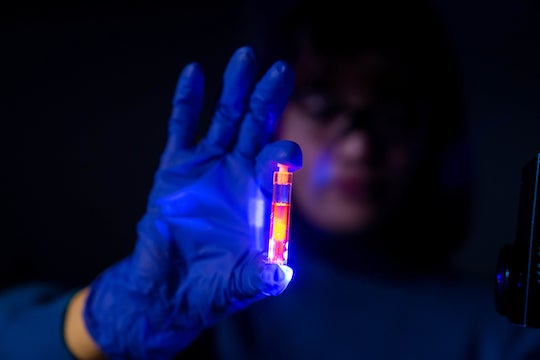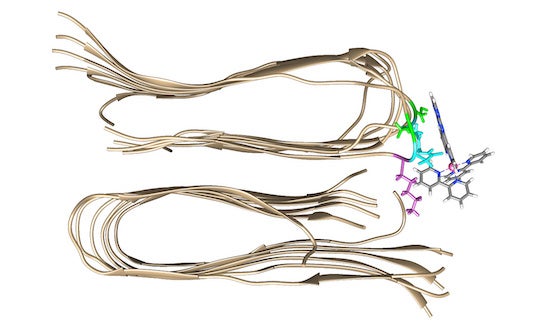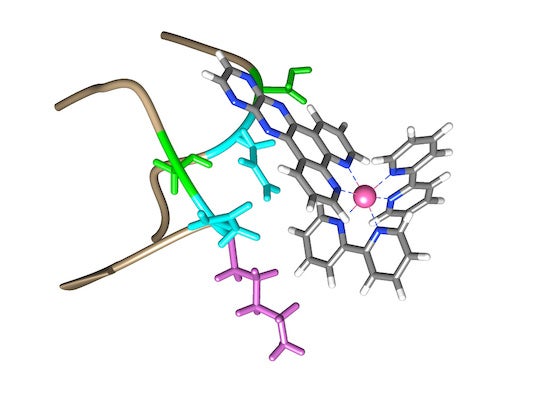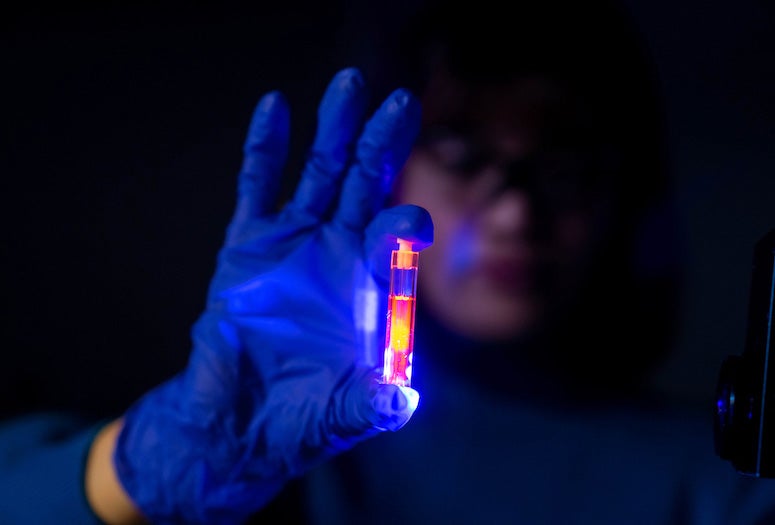Scientists from Rice University are using fluorescence lifetime to shed new light on a peptide associated with Alzheimer’s disease, which the Centers for Disease Control and Prevention estimates will affect nearly 14 million people in the U.S. by 2060.

(Photo by Gustavo Raskosky/Rice University)
Through a new approach using time-resolved spectroscopy and computational chemistry, Angel Martí and his team found experimental evidence of an alternative binding site on amyloid-beta aggregates, opening the door to the development of new therapies for Alzheimer’s and other diseases associated with amyloid deposits.
The study is published in Chemical Science.
Amyloid plaque deposits in the brain are a main feature of Alzheimer’s. “Amyloid-beta is a peptide that aggregates in the brains of people that suffer from Alzheimer’s disease, forming these supramolecular nanoscale fibers, or fibrils” said Martí, a professor of chemistry, bioengineering, and materials science and nanoengineering and faculty director of the Rice Emerging Scholars Program. “Once they grow sufficiently, these fibrils precipitate and form what we call amyloid plaques.
“Understanding how molecules in general bind to amyloid-beta is particularly important not only for developing drugs that will bind with better affinity to its aggregates, but also for figuring out who the other players are that contribute to cerebral tissue toxicity,” he added.

The Martí group had previously identified a first binding site for amyloid-beta deposits by figuring out how metallic dye molecules were able to bind to pockets formed by the fibrils. The molecules’ ability to fluoresce, or emit light when excited under a spectroscope, indicated the presence of the binding site.
Time-resolved spectroscopy, which the lab utilized in its latest discovery, “is an experimental technique that looks at the time that molecules spend in an excited state,” Martí said. “We excite the molecule with light, the molecule absorbs the energy from the light photons and gets to an excited state, a more energetic state.”
This energized state is responsible for the fluorescent glow. “We can measure the time that molecules spend in the excited state, which is called lifetime, and then we use that information to evaluate the binding equilibrium of small molecules to amyloid-beta,” Martí said.

In addition to the second binding site, the lab and collaborators from the University of Miami uncovered that multiple fluorescent dyes not expected to bind to amyloid deposits in fact did.
“These findings are allowing us to create a map of binding sites in amyloid-beta and a record of the amino acid compositions required for the formation of binding pockets in amyloid-beta fibrils,” Martí said.
The fact that time-resolved spectroscopy is sensitive to the environment around the dye molecule enabled Martí to infer the presence of the second binding site. “When the molecule is free in solution, its fluorescence has a particular lifetime that is due to this environment. However, when the molecule is bound to the amyloid fibers, the microenvironment is different and as a consequence so is the fluorescence lifetime,” he explained. “For the molecule bound to amyloid fibers, we observed two different fluorescence lifetimes.

(Photo by Gustavo Raskosky/Rice University)
“The molecule was not binding to a unique site in the amyloid-beta but to two different sites. And that was extremely interesting because our previous studies only indicated one binding site. That happened because we were not able to see all the components with the technologies we were using previously,” he added.
The discovery prompted more experimentation. “We decided to look into this further using not only the probe we designed, but also other molecules that have been used for decades in inorganic photochemistry,” he said. “The idea was to find a negative control, a molecule that would not bind to amyloid-beta. But what we discovered was that these molecules that we were not expecting would bind to amyloid-beta at all actually did bind to it with decent affinity.”
Martí said the findings will also impact the study of “many diseases associated with other kinds of amyloids: Parkinson’s, amyotrophic lateral sclerosis (ALS), Type 2 diabetes, systemic amyloidosis.”

Understanding the binding mechanisms of amyloid proteins is also useful for studying nonpathogenic amyloids and their potential applications in drug development and materials science.
“There are functional amyloids that our body and other organisms produce for different reasons that are not associated with diseases,” Martí said. “There are organisms that produce amyloids that have antibacterial effects. There are organisms that produce amyloids for structural purposes, to create barriers, and others that use amyloids for chemical storage. The study of nonpathogenic amyloids is an emerging area of science, so this is another path our findings can help develop.”
The National Science Foundation (2102563) and the family of the late Professor Donald DuPré, a Houston-born Rice alumnus and former professor of chemistry at the University of Louisville, supported the research.
-30-
- Peer-reviewed paper:
-
“Deconvoluting binding sites in amyloid nanofibrils using time-resolved spectroscopy” | Chemical Science | DOI: 10.1039/d2sc05418c
https://doi.org/ 10.1039/d2sc05418c
Authors: Bo Jiang, Utana Umezaki, Andrea Augustine, Vindi Jayasinghe-Arachchige, Leonardo Serafim, Zhi Mei Sonia He, Kevin Wyss, Rajeev Prabhakar and Angel Martí - Image downloads:
-
https://news-network.rice.edu/news/files/2023/01/00_Marti_fluorescent.jpg
CAPTION: A researcher in the lab of Rice’s Angel Martí holds a vial of fluorescent dye molecules in solution. Using time-resolved spectroscopy, which tracks the fluorescence lifetime of dye molecules, Martí and collaborators describe a second binding site on amyloid-beta deposits associated with Alzheimer’s disease, opening the door to the development of new therapies.
(Photo by Gustavo Raskosky/Rice University)
https://news-network.rice.edu/news/files/2023/01/00_Marti_binding_1_LG.jpg
CAPTION: A fluorescent dye molecule binds to a second binding site on the amyloid-beta protein fibril.
(Image courtesy of the Prabhakar Group/University of Miami)
https://news-network.rice.edu/news/files/2023/01/00_Marti_binding_2_LG.jpg
CAPTION: A close-up view shows a fluorescent dye molecule binding to the second known binding site on amyloid-beta aggregates.
(Image courtesy of the Prabhakar Group/University of Miami)
https://news-network.rice.edu/news/files/2023/01/230120_Marti-Lab_researchers_LG.jpg
CAPTION: Study co-authors (from left) Utana Umezaki, Zhi Mei Sonia He and Angel Martí.
(Photo by Gustavo Raskosky/Rice University)
https://news-network.rice.edu/news/files/2023/01/230120_Angel-Marti_LG.jpg
CAPTION: Angel Martí is a professor of chemistry, bioengineering, and materials science and nanoengineering and faculty director of the Rice Emerging Scholars Program.
(Photo by Gustavo Raskosky/Rice University)
- Related stories:
-
US names two Rice students inaugural Quad Fellows:
https://news.rice.edu/news/2022/us-names-two-rice-students-inaugural-quad-fellows
A little soap simplifies making 2D nanoflakes :
https://news.rice.edu/news/2021/little-soap-simplifies-making-2d-nanoflakes
Exotic nanotubes move in less mysterious ways:
https://news.rice.edu/news/2020/exotic-nanotubes-move-less-mysterious-ways
Martí named fellow of the Royal Society of Chemistry:
https://news.rice.edu/news/2020/marti-named-fellow-royal-society-chemistry
New clues illuminate Alzheimer’s roots:
https://news2.rice.edu/2013/07/22/new-clues-illuminate-alzheimers-roots/ - Links:
-
Wiess School of Natural Sciences: https://naturalsciences.rice.edu
George R. Brown School of Engineering: https://engineering.rice.edu
Angel Martí Group at Rice University: https://martigroup.rice.edu/
- About Rice:
-
Located on a 300-acre forested campus in Houston, Rice University is consistently ranked among the nation’s top 20 universities by U.S. News & World Report. Rice has highly respected schools of Architecture, Business, Continuing Studies, Engineering, Humanities, Music, Natural Sciences and Social Sciences and is home to the Baker Institute for Public Policy. With 4,240 undergraduates and 3,972 graduate students, Rice’s undergraduate student-to-faculty ratio is just under 6-to-1. Its residential college system builds close-knit communities and lifelong friendships, just one reason why Rice is ranked No. 1 for lots of race/class interaction and No. 1 for quality of life by the Princeton Review. Rice is also rated as a best value among private universities by Kiplinger’s Personal Finance.

